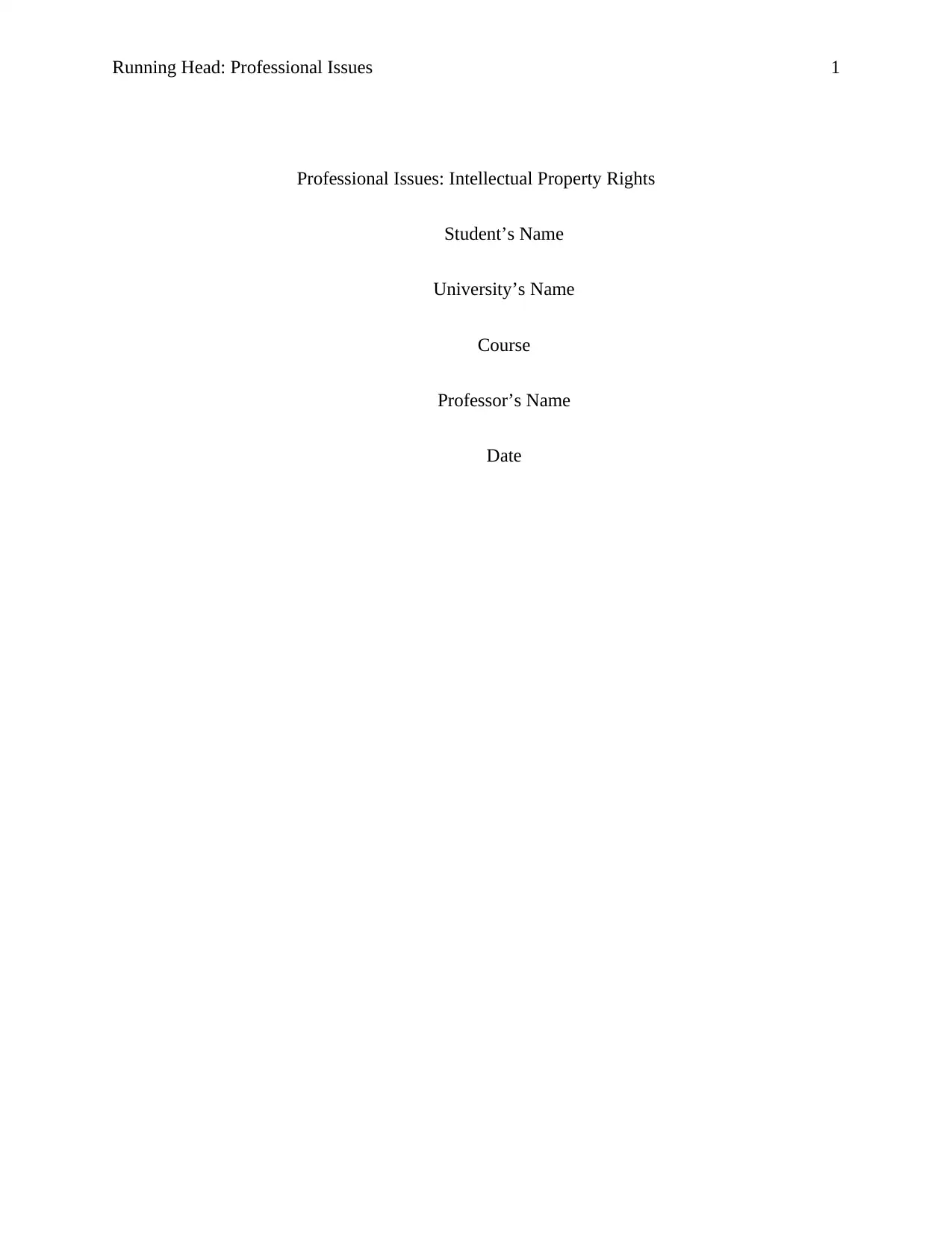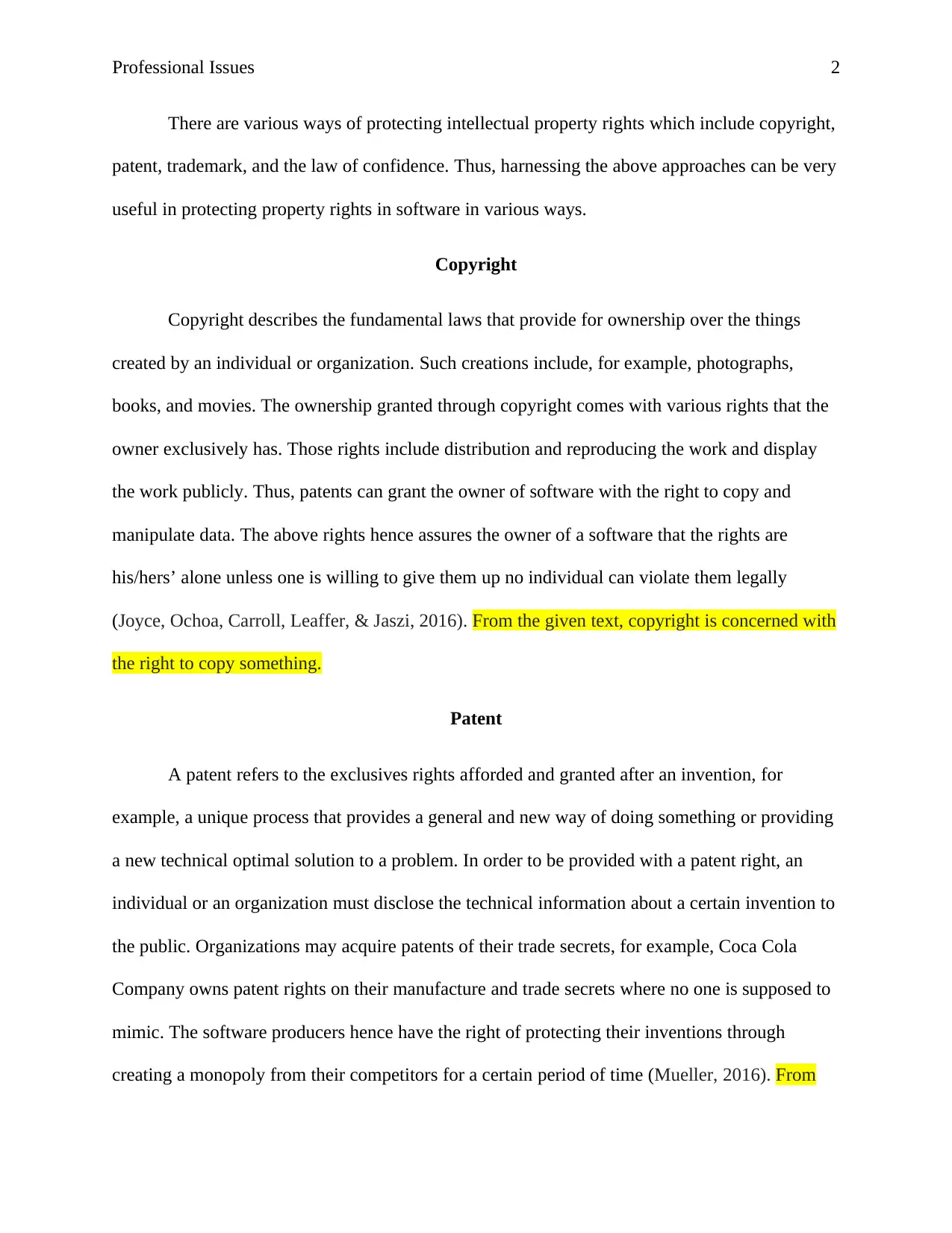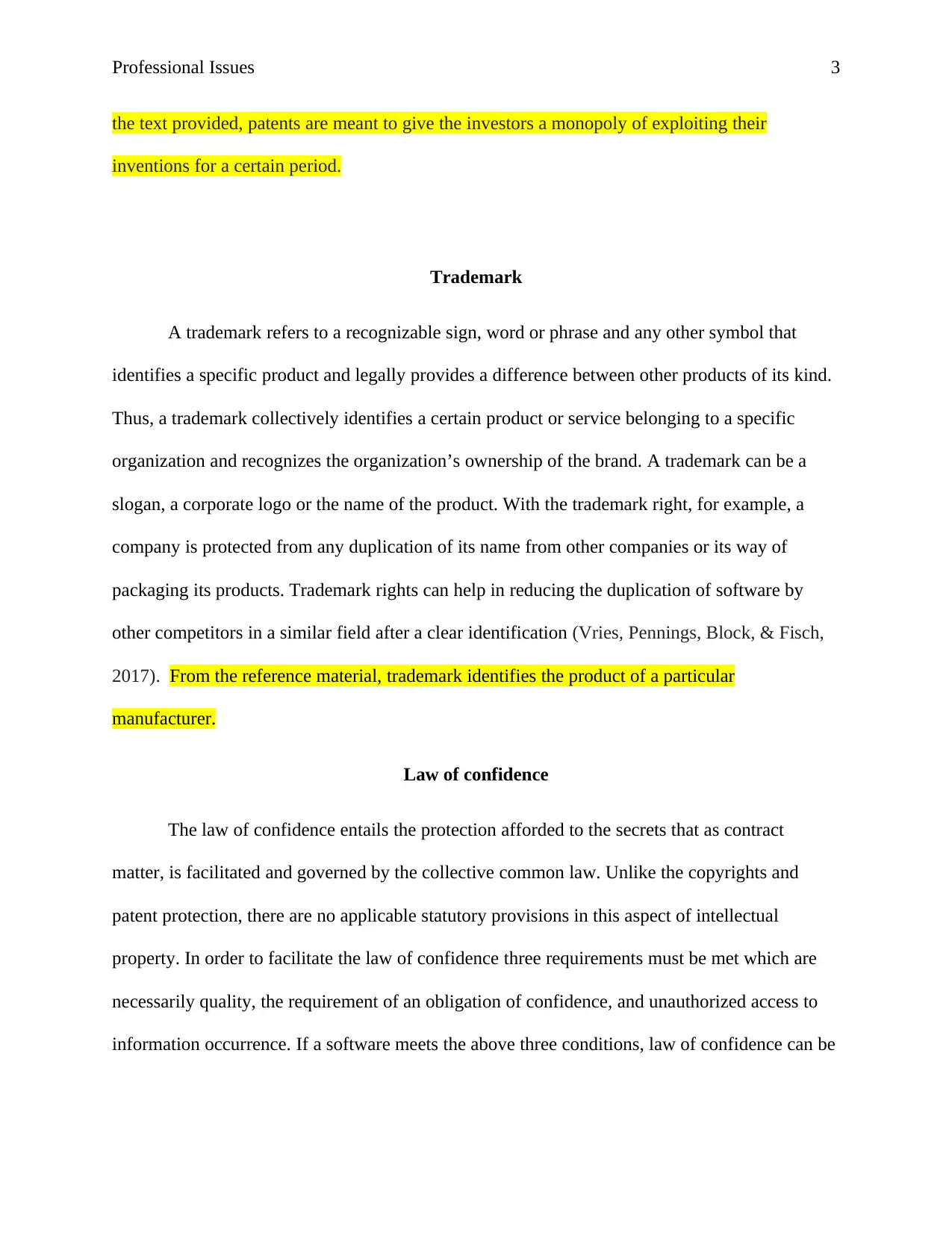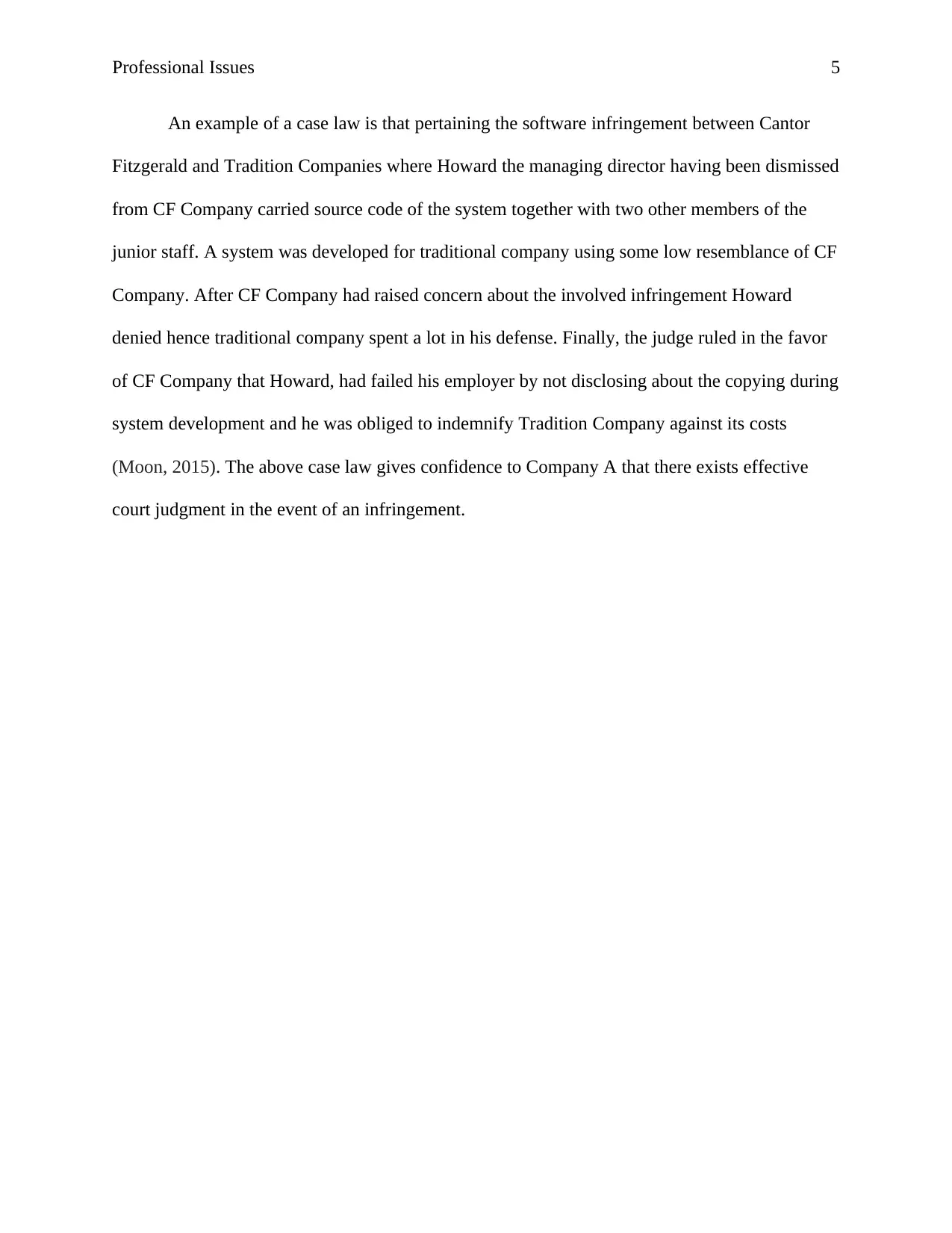COM6655 - Professional Issues: Intellectual Property Rights Report
VerifiedAdded on 2022/09/27
|6
|1285
|23
Report
AI Summary
This report delves into the crucial topic of intellectual property rights, specifically focusing on their application in the realm of software. It begins by outlining four primary methods of protection: copyright, patents, trademarks, and the law of confidence, providing a detailed explanation of each approach and its significance. The report then transitions into a practical scenario, analyzing a case where a British software house suspects infringement of its intellectual property by a competitor. The analysis explores how the software house could demonstrate infringement by leveraging the aforementioned intellectual property rights, referencing relevant legislation and case law to support its arguments. The report underscores the importance of establishing and protecting intellectual property in the software industry, offering insights into the legal mechanisms available to safeguard software innovations and prevent unauthorized use. The case study highlights the practical application of these concepts in a real-world business context.

Running Head: Professional Issues 1
Professional Issues: Intellectual Property Rights
Student’s Name
University’s Name
Course
Professor’s Name
Date
Professional Issues: Intellectual Property Rights
Student’s Name
University’s Name
Course
Professor’s Name
Date
Paraphrase This Document
Need a fresh take? Get an instant paraphrase of this document with our AI Paraphraser

Professional Issues 2
There are various ways of protecting intellectual property rights which include copyright,
patent, trademark, and the law of confidence. Thus, harnessing the above approaches can be very
useful in protecting property rights in software in various ways.
Copyright
Copyright describes the fundamental laws that provide for ownership over the things
created by an individual or organization. Such creations include, for example, photographs,
books, and movies. The ownership granted through copyright comes with various rights that the
owner exclusively has. Those rights include distribution and reproducing the work and display
the work publicly. Thus, patents can grant the owner of software with the right to copy and
manipulate data. The above rights hence assures the owner of a software that the rights are
his/hers’ alone unless one is willing to give them up no individual can violate them legally
(Joyce, Ochoa, Carroll, Leaffer, & Jaszi, 2016). From the given text, copyright is concerned with
the right to copy something.
Patent
A patent refers to the exclusives rights afforded and granted after an invention, for
example, a unique process that provides a general and new way of doing something or providing
a new technical optimal solution to a problem. In order to be provided with a patent right, an
individual or an organization must disclose the technical information about a certain invention to
the public. Organizations may acquire patents of their trade secrets, for example, Coca Cola
Company owns patent rights on their manufacture and trade secrets where no one is supposed to
mimic. The software producers hence have the right of protecting their inventions through
creating a monopoly from their competitors for a certain period of time (Mueller, 2016). From
There are various ways of protecting intellectual property rights which include copyright,
patent, trademark, and the law of confidence. Thus, harnessing the above approaches can be very
useful in protecting property rights in software in various ways.
Copyright
Copyright describes the fundamental laws that provide for ownership over the things
created by an individual or organization. Such creations include, for example, photographs,
books, and movies. The ownership granted through copyright comes with various rights that the
owner exclusively has. Those rights include distribution and reproducing the work and display
the work publicly. Thus, patents can grant the owner of software with the right to copy and
manipulate data. The above rights hence assures the owner of a software that the rights are
his/hers’ alone unless one is willing to give them up no individual can violate them legally
(Joyce, Ochoa, Carroll, Leaffer, & Jaszi, 2016). From the given text, copyright is concerned with
the right to copy something.
Patent
A patent refers to the exclusives rights afforded and granted after an invention, for
example, a unique process that provides a general and new way of doing something or providing
a new technical optimal solution to a problem. In order to be provided with a patent right, an
individual or an organization must disclose the technical information about a certain invention to
the public. Organizations may acquire patents of their trade secrets, for example, Coca Cola
Company owns patent rights on their manufacture and trade secrets where no one is supposed to
mimic. The software producers hence have the right of protecting their inventions through
creating a monopoly from their competitors for a certain period of time (Mueller, 2016). From

Professional Issues 3
the text provided, patents are meant to give the investors a monopoly of exploiting their
inventions for a certain period.
Trademark
A trademark refers to a recognizable sign, word or phrase and any other symbol that
identifies a specific product and legally provides a difference between other products of its kind.
Thus, a trademark collectively identifies a certain product or service belonging to a specific
organization and recognizes the organization’s ownership of the brand. A trademark can be a
slogan, a corporate logo or the name of the product. With the trademark right, for example, a
company is protected from any duplication of its name from other companies or its way of
packaging its products. Trademark rights can help in reducing the duplication of software by
other competitors in a similar field after a clear identification (Vries, Pennings, Block, & Fisch,
2017). From the reference material, trademark identifies the product of a particular
manufacturer.
Law of confidence
The law of confidence entails the protection afforded to the secrets that as contract
matter, is facilitated and governed by the collective common law. Unlike the copyrights and
patent protection, there are no applicable statutory provisions in this aspect of intellectual
property. In order to facilitate the law of confidence three requirements must be met which are
necessarily quality, the requirement of an obligation of confidence, and unauthorized access to
information occurrence. If a software meets the above three conditions, law of confidence can be
the text provided, patents are meant to give the investors a monopoly of exploiting their
inventions for a certain period.
Trademark
A trademark refers to a recognizable sign, word or phrase and any other symbol that
identifies a specific product and legally provides a difference between other products of its kind.
Thus, a trademark collectively identifies a certain product or service belonging to a specific
organization and recognizes the organization’s ownership of the brand. A trademark can be a
slogan, a corporate logo or the name of the product. With the trademark right, for example, a
company is protected from any duplication of its name from other companies or its way of
packaging its products. Trademark rights can help in reducing the duplication of software by
other competitors in a similar field after a clear identification (Vries, Pennings, Block, & Fisch,
2017). From the reference material, trademark identifies the product of a particular
manufacturer.
Law of confidence
The law of confidence entails the protection afforded to the secrets that as contract
matter, is facilitated and governed by the collective common law. Unlike the copyrights and
patent protection, there are no applicable statutory provisions in this aspect of intellectual
property. In order to facilitate the law of confidence three requirements must be met which are
necessarily quality, the requirement of an obligation of confidence, and unauthorized access to
information occurrence. If a software meets the above three conditions, law of confidence can be
⊘ This is a preview!⊘
Do you want full access?
Subscribe today to unlock all pages.

Trusted by 1+ million students worldwide

Professional Issues 4
assured hence affording the protection from any infringement (Brown, Kheria, Iljadica, &
Cornwell, 2019).
Possible ways of showing property rights infringement.
Copyright infringement refers to when someone makes use of the copyright-protected
work belonging to someone else without permission (Jamali, 2017). From the case provided
between a British software house and the new B limited company in the UK, it is clear that
infringement of the property might have occurred. This is because the product produced by
Company B really resembled that of company A where no consent was sought upon the
production.
Company A should first make sure that it has valid intellectual property rights. The
company should make sure that their ownership over the things created by an organization could
be effectively tracked through copyright. This is important since company A will be able to
demonstrate having protected its gaming software from any copy and manipulation. Company A
should also ensure that it has valid patent rights. The patents are important to the company
protecting their unique gaming invention which should not be mimicked by any other with no
relevant authority. Company A should also be able to prove that the name of the game and advert
can be traced from its legal acquired trademark. Before engaging with the court having
ascertained that there are valid and legal intellectual property rights put in place, the company
should be able to adhere to the law of confidence. The company should be able to demonstrate
that it has produced the necessary gaming quality, have all the requirements of an obligation of
confidence put in place and prove that there has been unauthorized access to its data.
assured hence affording the protection from any infringement (Brown, Kheria, Iljadica, &
Cornwell, 2019).
Possible ways of showing property rights infringement.
Copyright infringement refers to when someone makes use of the copyright-protected
work belonging to someone else without permission (Jamali, 2017). From the case provided
between a British software house and the new B limited company in the UK, it is clear that
infringement of the property might have occurred. This is because the product produced by
Company B really resembled that of company A where no consent was sought upon the
production.
Company A should first make sure that it has valid intellectual property rights. The
company should make sure that their ownership over the things created by an organization could
be effectively tracked through copyright. This is important since company A will be able to
demonstrate having protected its gaming software from any copy and manipulation. Company A
should also ensure that it has valid patent rights. The patents are important to the company
protecting their unique gaming invention which should not be mimicked by any other with no
relevant authority. Company A should also be able to prove that the name of the game and advert
can be traced from its legal acquired trademark. Before engaging with the court having
ascertained that there are valid and legal intellectual property rights put in place, the company
should be able to adhere to the law of confidence. The company should be able to demonstrate
that it has produced the necessary gaming quality, have all the requirements of an obligation of
confidence put in place and prove that there has been unauthorized access to its data.
Paraphrase This Document
Need a fresh take? Get an instant paraphrase of this document with our AI Paraphraser

Professional Issues 5
An example of a case law is that pertaining the software infringement between Cantor
Fitzgerald and Tradition Companies where Howard the managing director having been dismissed
from CF Company carried source code of the system together with two other members of the
junior staff. A system was developed for traditional company using some low resemblance of CF
Company. After CF Company had raised concern about the involved infringement Howard
denied hence traditional company spent a lot in his defense. Finally, the judge ruled in the favor
of CF Company that Howard, had failed his employer by not disclosing about the copying during
system development and he was obliged to indemnify Tradition Company against its costs
(Moon, 2015). The above case law gives confidence to Company A that there exists effective
court judgment in the event of an infringement.
An example of a case law is that pertaining the software infringement between Cantor
Fitzgerald and Tradition Companies where Howard the managing director having been dismissed
from CF Company carried source code of the system together with two other members of the
junior staff. A system was developed for traditional company using some low resemblance of CF
Company. After CF Company had raised concern about the involved infringement Howard
denied hence traditional company spent a lot in his defense. Finally, the judge ruled in the favor
of CF Company that Howard, had failed his employer by not disclosing about the copying during
system development and he was obliged to indemnify Tradition Company against its costs
(Moon, 2015). The above case law gives confidence to Company A that there exists effective
court judgment in the event of an infringement.

Professional Issues 6
References
Brown, A., Kheria, S., Iljadica, M., & Cornwell, J. (2019). Contemporary Intellectual Property:
Law and Policy. Oxford University Press, USA.
De Vries, G., Pennings, E., Block, J. H., & Fisch, C. (2017). Trademark or patent? The effects of
market concentration, customer type and venture capital financing on start-ups’ initial IP
applications. Industry and Innovation, 24(4), 325-345.
Jamali, H. R. (2017). Copyright compliance and infringement in ResearchGate full-text journal
articles. Scientometrics, 112(1), 241-254.
Joyce, C., Ochoa, T. T., Carroll, M. W., Leaffer, M. A., & Jaszi, P. (2016). Copyright law (Vol.
85). Durham, NC: Carolina Academic Press.
Mueller, J. M. (2016). Essay: Studying Patent Law in 2016. Available at SSRN 2812733.
Moon, K. (2015). Another nail in the coffin for non-literal software copyright
infringement?. Journal of Intellectual Property Law & Practice, 10(12), 921-930.
References
Brown, A., Kheria, S., Iljadica, M., & Cornwell, J. (2019). Contemporary Intellectual Property:
Law and Policy. Oxford University Press, USA.
De Vries, G., Pennings, E., Block, J. H., & Fisch, C. (2017). Trademark or patent? The effects of
market concentration, customer type and venture capital financing on start-ups’ initial IP
applications. Industry and Innovation, 24(4), 325-345.
Jamali, H. R. (2017). Copyright compliance and infringement in ResearchGate full-text journal
articles. Scientometrics, 112(1), 241-254.
Joyce, C., Ochoa, T. T., Carroll, M. W., Leaffer, M. A., & Jaszi, P. (2016). Copyright law (Vol.
85). Durham, NC: Carolina Academic Press.
Mueller, J. M. (2016). Essay: Studying Patent Law in 2016. Available at SSRN 2812733.
Moon, K. (2015). Another nail in the coffin for non-literal software copyright
infringement?. Journal of Intellectual Property Law & Practice, 10(12), 921-930.
⊘ This is a preview!⊘
Do you want full access?
Subscribe today to unlock all pages.

Trusted by 1+ million students worldwide
1 out of 6
Related Documents
Your All-in-One AI-Powered Toolkit for Academic Success.
+13062052269
info@desklib.com
Available 24*7 on WhatsApp / Email
![[object Object]](/_next/static/media/star-bottom.7253800d.svg)
Unlock your academic potential
Copyright © 2020–2025 A2Z Services. All Rights Reserved. Developed and managed by ZUCOL.





